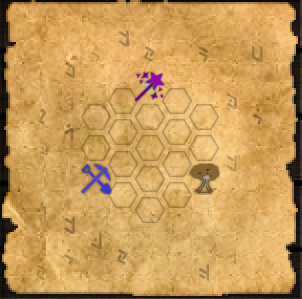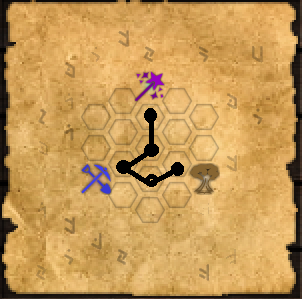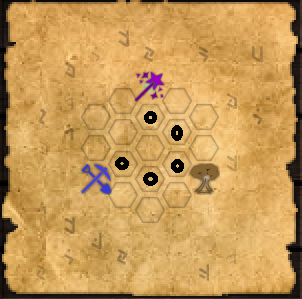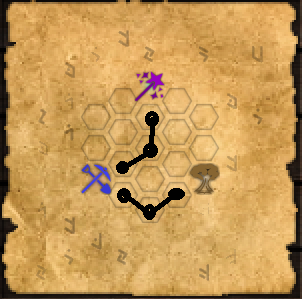Before you ask: Yes, I do know that there's a website that does this for you. However, this is for those who actually want to do the work, but don't want to waste valuable research points (and don't have the nifty Deconstruction Table yet) on trial and error. And, better yet, this process will cover any and all Thaumcraft add-ons, because it doesn't rely on definitions of aspects. If an aspect in the Thaumonomicon, it works in this process!
The Original, Efficiency-Centred Method
(I'm compiling faster methods down below that aren't fully efficient, but lower down the grind considerably!)
This is my original, mostly unintelligible summary of my research process, which will of course be further explained, step by step:
Create a Branch section for each base. At the beginning of the Branch, write what makes the base and what the base makes. On the next lines, write what each previously listed item is made out of and makes. If an item is shared by all the Branches at an equal distance from the base, then you are done. If not, use the item that is shared by the most Branches in the centre and then find a way to connect the outlying Branch with one of the other Branches.
This is (probably) entirely useless, unless you're me. So, clearly, we need pictures, because everything needs pictures. Everything.

We're going to arbitrarily study the research for Greatwood wand cores. Now, let's begin with defining what I mean by "base". If it isn't clear already by the picture, a base is one of the aspects already there on the note to begin with. In this case, those aspects are Praecantatio, Instrumentum, and Arbor.
In order to complete a research note, you have to be able to link up all three aspects in some way. The most efficient configuration of linkage would be the one that connects all the aspects together in the shortest number of steps. And in this case, that most efficient configuration would be for all the aspects to meet up at an equal distance from each other. So, we need to find some aspect to put in the centre that we can connect to each of the bases.
To link an aspect to another, the new aspect must be made of or a component of the aspect already placed. So what I do, first of all, is create a "Branch" for each base. What is a Branch? Observe the first two lines of a Branch, first of all:
Branch 1:
Instrumentum: Humanus, Ordo (makes Fabrico, Meto, Pannus, Telum, Tutamen)
That list of aspects is every single aspect that can connect to Instrumentum. Now what we're going to do is find out what aspects connect to those aspects, in the next lines of the Branch:
Humanus: Bestia, Cognitio (makes Fabrico, Instrumentum, Lucrum, Messis, Perfodio)
Ordo: Makes instrumentum, Motus, Permutatio, Potentia, Sano, Vitreus
Fabrico: Humanus, Instrumentum
Meto: Messis, Instrumentum
Pannus: Instrumentum, Bestia
Telum: Instrumentum, Ignis
Tutamen: Instrumentum, Terra
The aspects listed after the colons are all the aspects that can be placed in the middle. At first, this doesn't seem very useful. And it really isn't. Not yet. Now we need to create another Branch, which will be for Praecantatio.
Branch 2:
Praecantatio: Vacuos, Potentia (Makes Vitium)
Vacuos: Aer, Perditio (makes Alienis, Fames, Praecantatio, Tenebrae)
Potentia: Ordo, Ignis (makes Praecantatio)
Vitium: Praecantatio, Perditio
You may notice that one aspect in the list of middles is shared by both Branches. That is Ignis. That gives us only one candidate for the middle of the Research Note. So now it's time for Arbor.
Branch 3:
Arbor: Aer, Herba
Aer: Not a candidate
Herba: Victus, Terra (makes Arbor, Messis)
Why is Aer "not a candidate"? Well, both middle candidates are primal aspects. Since Aer only makes aspects, it can't be connected to any primal aspects. So, clearly, it would be a waste to list it.
Wait! There are no aspects in Branch 3 that match our middle candidates! That means that there is no way we can connect Arbor to the middle in the most efficient configuration. Thus, the next best thing is to connect it to the next closest aspects, in a configuration like so:

(We could also connect it to the topmost black circle.)
Those closest aspects are the aspects in Branch 1 and 2 that connect the bases to the middle candidates. Which are those?
Alpha Connections:
Potentia, Telum
So we have to find a way to connect Arbor to one of those two. Let's go back to Branch 3 and list all the aspects that Aer makes, since the aspects that connect to Herba aren't Potentia or Telum.
Aer: Makes Arbor, Lux, Motus, Sensus, Vacuos, Volatus.
Now what we're going to do is make another list, this time to see if Potentia or Telum can connect with any of the connections to Aer and Herba. This one will be easier, because all we need to do is copy our list for Potentia and Telum.
Alpha Connections:
Potentia: Ordo, Ignis (makes Praecantatio)
Telum: Instrumentum, Ignis
As you can see, it's worse now. Even if we extend Arbor's Branch out by one, we still can't connect! So the next step is to discard Ignis as a middle candidate and see if we can find a new candidate that is shared with Branch 3 and one of the other two branches. Our new middle candidates are Motus, Terra, and Messis, all of which are shared with Branch 1.
Since Branch 2 shares none of those middle candidates, we're going to have to extend it out like we tried to do with Arbor's Branch.
Beta Connections:
Ordo, Aer, Tutamen, Herba, Meto
And then we copy our lists:
Ordo: Makes Instrumentum, Motus, Permutatio, Potentia, Sano, Vitreus
Aer: Makes Arbor, Lux, Motus, Sensus, Vacuos, Volatus.
Tutamen: Instrumentum, Terra
Herba: Victus, Terra (makes Arbor, Messis)
Meto: Messis, Instrumentum
And now we check if any of the third-order aspects (the aspects listed after the colons in the second section of a Branch) are shared with our lists. Unfortunately, none of them do. This means that by now we have exhausted all possible five aspect point configurations. Imagine if we had been trying to do this by trial and error! We would have wasted countless research points. You may ask at this point why we aren't trying a configuration like this:

This is essentially asking us to find two shared middles. This would be all well and good, but we already established that Arbor does not share a middle with Praecantatio. So we can't do that. What do we do now? It's time to search through our six-point configurations.
First, we're going to return to the first configuration that we tried to make: One where Praecantatio and Instrumentum held the shared middle. But this time, we're going to connect Arbor to the bases themselves. Now, we know that we can't do this with Praecantatio (at least in a configuration with three spaces between them). But we can do this with Instrumentum, because we've already found that they share three middles! The three possible configurations for connecting Instrumentum to Arbor are as follows:
Ordo, Motus, Aer
Tutamen, Terra, Herba
Meto, Messis, Herba
And from that you just choose whichever works best for you. And thus, our final configuration is:

So, let's summarise the process. (Otherwise known as TL;DR)
Find the centre of the bases: the slot that is an equal distance away from all of them. Then create a Branch for each base: A list of all the aspects that can connect to a base, and all the aspects that can connect to those, and so on until the distance to the centre is completed. Then find a centre aspect that is shared by all the bases. If you can't find an aspect that is shared by all the bases, take the ones that are shared by the greatest number of them, and then try to connect the outlying base to an aspect in between one possible centre and the other bases.
If there's no way to do that, try all the other possible centres. If none of those work, try and find centres shared by the outlying base and one of the other bases. Once you have those, try and connect the new outlying base to an aspect between one of the new possible centres and the other bases. If that doesn't work, then take any one of the original possible centres and use that. Connect the outlying base, then, with another of the bases, separately.
And this was not mentioned: If you still can't do that, try connecting the outlying base to one of the other bases with four aspects in between. And if by then it still doesn't work (although that is extremely unlikely) make that five.
All this is with no trial and error, at least in the research table. It exhausts all possible configurations from smallest to largest in the fastest way it can, and can even give you multiple choices.
Tell me if this helped you! If I could only ever get one thing out of posting this, it would be feedback, whether it be "This is how you can improve your method" or "Wow, this method works really well for me!" or even "Your method is horrible and should never be used, ever!"
Well, actually, I probably wouldn't want that third one (unless there's a reason behind it, in which case it's fine by me).
Wait, Mister! I want it faster!
Then faster it is. Lnaeo introduced me to the research technique of primalisation: taking a base and converting it all the way down to one of its primal aspects. How is this useful, and how is it speedy?
Converting a higher tier aspect (an aspect that is made of other aspects) to a primal aspect is easy. Incidentally, that's because all aspects come from primal aspects. Crazy, I know. Now, while this doesn't always result in a perfectly efficient configuration, there's still ways to make it as efficient as possible with minimal trial and error.
For example, you can easily list all of the primals that make up an aspect. Since almost every combination of primals is covered by higher tier aspects, and you'll get at least two primals for every aspect, it is very likely that a primal aspect will be shared by every single list you have.
But wait! you say. What if, when I primalise my bases, the final primals are too far away from each other? How do I connect them, then?
To solve this, lnaeo introduced to me the idea of cycles: a length of easily obtained aspects that can turn one primal aspect into another over a certain length, or just extend the length of a branch outwards and return right back to the original aspect. Later, I'll spend some time coming up with the cheapest cycles there are to help you with that. Now you might ask what happens if the base aspect is a primal aspect. This can also be solved using cycles.
That should be it for a faster method! If anyone has any suggestions for other ways to go about this, feel free to suggest them, so others can choose which one they want to go through with.
And, of course, there's bound to be a lot of great information at the official Thaumcraft Forums (although how they got 26.000 posts concerning a single mod is beyond me), if you have the time to search through it all. But that's what guides like these are for--so you can get others to do that tedious searching for you!
Well, probably. I'm not telepathic, so I can't see in your minds and find out why you like guides. Alas.
The Original, Efficiency-Centred Method
(I'm compiling faster methods down below that aren't fully efficient, but lower down the grind considerably!)
This is my original, mostly unintelligible summary of my research process, which will of course be further explained, step by step:
Create a Branch section for each base. At the beginning of the Branch, write what makes the base and what the base makes. On the next lines, write what each previously listed item is made out of and makes. If an item is shared by all the Branches at an equal distance from the base, then you are done. If not, use the item that is shared by the most Branches in the centre and then find a way to connect the outlying Branch with one of the other Branches.
This is (probably) entirely useless, unless you're me. So, clearly, we need pictures, because everything needs pictures. Everything.

We're going to arbitrarily study the research for Greatwood wand cores. Now, let's begin with defining what I mean by "base". If it isn't clear already by the picture, a base is one of the aspects already there on the note to begin with. In this case, those aspects are Praecantatio, Instrumentum, and Arbor.
In order to complete a research note, you have to be able to link up all three aspects in some way. The most efficient configuration of linkage would be the one that connects all the aspects together in the shortest number of steps. And in this case, that most efficient configuration would be for all the aspects to meet up at an equal distance from each other. So, we need to find some aspect to put in the centre that we can connect to each of the bases.
To link an aspect to another, the new aspect must be made of or a component of the aspect already placed. So what I do, first of all, is create a "Branch" for each base. What is a Branch? Observe the first two lines of a Branch, first of all:
Branch 1:
Instrumentum: Humanus, Ordo (makes Fabrico, Meto, Pannus, Telum, Tutamen)
That list of aspects is every single aspect that can connect to Instrumentum. Now what we're going to do is find out what aspects connect to those aspects, in the next lines of the Branch:
Humanus: Bestia, Cognitio (makes Fabrico, Instrumentum, Lucrum, Messis, Perfodio)
Ordo: Makes instrumentum, Motus, Permutatio, Potentia, Sano, Vitreus
Fabrico: Humanus, Instrumentum
Meto: Messis, Instrumentum
Pannus: Instrumentum, Bestia
Telum: Instrumentum, Ignis
Tutamen: Instrumentum, Terra
The aspects listed after the colons are all the aspects that can be placed in the middle. At first, this doesn't seem very useful. And it really isn't. Not yet. Now we need to create another Branch, which will be for Praecantatio.
Branch 2:
Praecantatio: Vacuos, Potentia (Makes Vitium)
Vacuos: Aer, Perditio (makes Alienis, Fames, Praecantatio, Tenebrae)
Potentia: Ordo, Ignis (makes Praecantatio)
Vitium: Praecantatio, Perditio
You may notice that one aspect in the list of middles is shared by both Branches. That is Ignis. That gives us only one candidate for the middle of the Research Note. So now it's time for Arbor.
Branch 3:
Arbor: Aer, Herba
Aer: Not a candidate
Herba: Victus, Terra (makes Arbor, Messis)
Why is Aer "not a candidate"? Well, both middle candidates are primal aspects. Since Aer only makes aspects, it can't be connected to any primal aspects. So, clearly, it would be a waste to list it.
Wait! There are no aspects in Branch 3 that match our middle candidates! That means that there is no way we can connect Arbor to the middle in the most efficient configuration. Thus, the next best thing is to connect it to the next closest aspects, in a configuration like so:

(We could also connect it to the topmost black circle.)
Those closest aspects are the aspects in Branch 1 and 2 that connect the bases to the middle candidates. Which are those?
Alpha Connections:
Potentia, Telum
So we have to find a way to connect Arbor to one of those two. Let's go back to Branch 3 and list all the aspects that Aer makes, since the aspects that connect to Herba aren't Potentia or Telum.
Aer: Makes Arbor, Lux, Motus, Sensus, Vacuos, Volatus.
Now what we're going to do is make another list, this time to see if Potentia or Telum can connect with any of the connections to Aer and Herba. This one will be easier, because all we need to do is copy our list for Potentia and Telum.
Alpha Connections:
Potentia: Ordo, Ignis (makes Praecantatio)
Telum: Instrumentum, Ignis
As you can see, it's worse now. Even if we extend Arbor's Branch out by one, we still can't connect! So the next step is to discard Ignis as a middle candidate and see if we can find a new candidate that is shared with Branch 3 and one of the other two branches. Our new middle candidates are Motus, Terra, and Messis, all of which are shared with Branch 1.
Since Branch 2 shares none of those middle candidates, we're going to have to extend it out like we tried to do with Arbor's Branch.
Beta Connections:
Ordo, Aer, Tutamen, Herba, Meto
And then we copy our lists:
Ordo: Makes Instrumentum, Motus, Permutatio, Potentia, Sano, Vitreus
Aer: Makes Arbor, Lux, Motus, Sensus, Vacuos, Volatus.
Tutamen: Instrumentum, Terra
Herba: Victus, Terra (makes Arbor, Messis)
Meto: Messis, Instrumentum
And now we check if any of the third-order aspects (the aspects listed after the colons in the second section of a Branch) are shared with our lists. Unfortunately, none of them do. This means that by now we have exhausted all possible five aspect point configurations. Imagine if we had been trying to do this by trial and error! We would have wasted countless research points. You may ask at this point why we aren't trying a configuration like this:

This is essentially asking us to find two shared middles. This would be all well and good, but we already established that Arbor does not share a middle with Praecantatio. So we can't do that. What do we do now? It's time to search through our six-point configurations.
First, we're going to return to the first configuration that we tried to make: One where Praecantatio and Instrumentum held the shared middle. But this time, we're going to connect Arbor to the bases themselves. Now, we know that we can't do this with Praecantatio (at least in a configuration with three spaces between them). But we can do this with Instrumentum, because we've already found that they share three middles! The three possible configurations for connecting Instrumentum to Arbor are as follows:
Ordo, Motus, Aer
Tutamen, Terra, Herba
Meto, Messis, Herba
And from that you just choose whichever works best for you. And thus, our final configuration is:

So, let's summarise the process. (Otherwise known as TL;DR)
Find the centre of the bases: the slot that is an equal distance away from all of them. Then create a Branch for each base: A list of all the aspects that can connect to a base, and all the aspects that can connect to those, and so on until the distance to the centre is completed. Then find a centre aspect that is shared by all the bases. If you can't find an aspect that is shared by all the bases, take the ones that are shared by the greatest number of them, and then try to connect the outlying base to an aspect in between one possible centre and the other bases.
If there's no way to do that, try all the other possible centres. If none of those work, try and find centres shared by the outlying base and one of the other bases. Once you have those, try and connect the new outlying base to an aspect between one of the new possible centres and the other bases. If that doesn't work, then take any one of the original possible centres and use that. Connect the outlying base, then, with another of the bases, separately.
And this was not mentioned: If you still can't do that, try connecting the outlying base to one of the other bases with four aspects in between. And if by then it still doesn't work (although that is extremely unlikely) make that five.
All this is with no trial and error, at least in the research table. It exhausts all possible configurations from smallest to largest in the fastest way it can, and can even give you multiple choices.
Tell me if this helped you! If I could only ever get one thing out of posting this, it would be feedback, whether it be "This is how you can improve your method" or "Wow, this method works really well for me!" or even "Your method is horrible and should never be used, ever!"
Well, actually, I probably wouldn't want that third one (unless there's a reason behind it, in which case it's fine by me).
I'm working on a guide for if there are more than three bases and they don't have an actual centre. It'll be here soon, for those of you who still haven't gotten the deconstruction table and really, really don't want to.
Wait, Mister! I want it faster!
Then faster it is. Lnaeo introduced me to the research technique of primalisation: taking a base and converting it all the way down to one of its primal aspects. How is this useful, and how is it speedy?
Converting a higher tier aspect (an aspect that is made of other aspects) to a primal aspect is easy. Incidentally, that's because all aspects come from primal aspects. Crazy, I know. Now, while this doesn't always result in a perfectly efficient configuration, there's still ways to make it as efficient as possible with minimal trial and error.
For example, you can easily list all of the primals that make up an aspect. Since almost every combination of primals is covered by higher tier aspects, and you'll get at least two primals for every aspect, it is very likely that a primal aspect will be shared by every single list you have.
But wait! you say. What if, when I primalise my bases, the final primals are too far away from each other? How do I connect them, then?
To solve this, lnaeo introduced to me the idea of cycles: a length of easily obtained aspects that can turn one primal aspect into another over a certain length, or just extend the length of a branch outwards and return right back to the original aspect. Later, I'll spend some time coming up with the cheapest cycles there are to help you with that. Now you might ask what happens if the base aspect is a primal aspect. This can also be solved using cycles.
That should be it for a faster method! If anyone has any suggestions for other ways to go about this, feel free to suggest them, so others can choose which one they want to go through with.
And, of course, there's bound to be a lot of great information at the official Thaumcraft Forums (although how they got 26.000 posts concerning a single mod is beyond me), if you have the time to search through it all. But that's what guides like these are for--so you can get others to do that tedious searching for you!
Well, probably. I'm not telepathic, so I can't see in your minds and find out why you like guides. Alas.
Last edited: